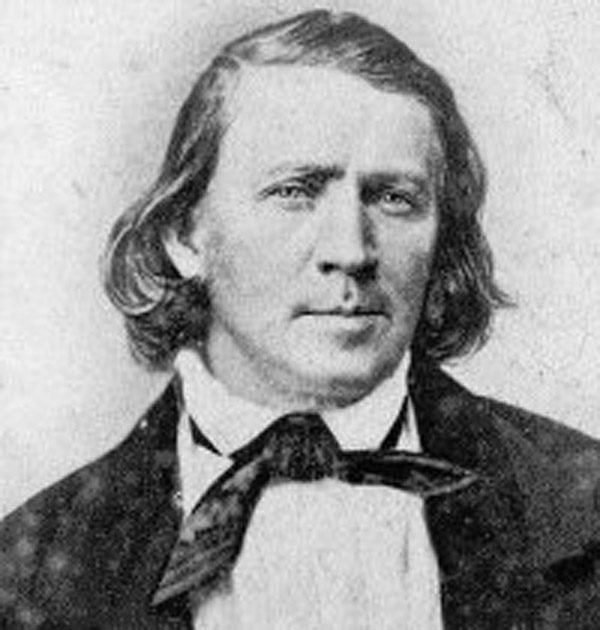
(Wikimedia Commons public domain image)
***
In his important book Religion of a Different Color, Paul Reeve recounts an interesting episode involving Brigham Young:
An early mixed-race (Black and American Indian) member of the Church named William McCary — a rather tenuous and somewhat erratic and even unbalanced fellow, as it turned out, who ultimately didn’t endure faithfully to the end — had encountered racial prejudice among some Church members.
In response to this, President Young counseled the Saints to “use the man with respect.” (The verb to use is employed here in a somewhat archaic sense common in Shakespeare. See below. In today’s English, we would use the verb to treat.)
But some problems persisted. And he continued to complain.
Was he in some way sub- or even non-human?
“Its nothing to do with the blood,” replied President Young, “for of one blood has God made all flesh.”
Professor Reeve comments on this exchange:
“It was an echo of the same New Testament verse (Acts 17:26) that [Joseph] Smith quoted in his presidential platform three years earlier. Both drew upon the Bible to assert a broad commonality among humankind and were simultaneously acknowledging a wider racial debate then animating the scientific and Christian communities. In paraphrasing Acts 17:26, Young and Smith were referencing an important verse then commonly cited among nineteenth-century Christians. Believers used the verse to defend against a polygenesis theory then stirring scientific arguments about the origins of the various races. Scientists who promoted the polygenesis theory believed that there were multiple independent creations rather than just a single biblical creation. Each creation gave rise to a new race, which meant that whites and blacks were in fact from different species. Even though the two species could biologically reproduce, one argument was that an innate repugnance against interracial mixing was intended to preserve ‘species distinction.’ Those who violated the innate repugnance were really violating nature, which was a sure sign of their moral degradation. Physical degeneracy followed and within a few generations the offspring of such unions would be sterile.”
See W. Paul Reeve, Religion of a Different Color: Race and the Mormon Struggle for Whiteness (New York and Oxford: Oxford University Press, 2015), 128-131.
It’s been fashionable in recent years to demonize Brigham Young as a racist, even a vicious one — and, in some cases, essentially to forget that there was anything else to the man.
I resist this.
He wasn’t perfect, of course.
Nor has any subsequent apostle or president of the Church been. Nor am I. Nor are his critics.
“Use every man after his desert,” wrote Shakespeare (in Hamlet II.ii), “and who should ‘scape whipping?” Or, to paraphrase: Treat everybody purely according to his or her merits, and who wouldn’t be worthy of censure or even punishment?
In racial matters, Brigham Young said some things that jar us today, and that we cannot endorse. There’s no denying this. He was, as we all are — even the prophets among us — a man of his time and culture and background.
But he was a good man, a remarkable man, indeed a great man, a sincere disciple of the Lord and a prophet who sought to do God’s will.
I choose to stand with him. “The soul that on Jesus hath leaned for repose I will not, I cannot, desert to his foes.” And, on the specific racial issue described above, President Brigham Young was — notwithstanding the dismissive stereotype of him that’s currently in vogue — on the side of the angels.
***
And now, on a very different note, some thoughts in the general area of science and religion, culminating with a quotation from, well, Brigham Young:
“Science has faith. We make postulates. We can’t prove those postulates, but we have faith in them.”
Charles H. Townes (Nobel Prize in Physics, 1964)
Dr. Townes believed that “science and religion [are] quite parallel, much more similar than most people think and that in the long run, they must converge.” “Science,” he wrote, “tries to understand what our universe is like and how it works, including us humans. Religion is aimed at understanding the purpose and meaning of our universe, including our own lives. If the universe has a purpose or meaning, this must be reflected in its structure and functioning, and hence in science.”
“He was one of the most important experimental physicists of the last century,” remarked Dr. Reinhard Genzel, a professor of physics at the University of California at Berkeley, upon the death of Dr. Townes. “His strength was his curiosity and his unshakable optimism, based on his deep Christian spirituality.”
“Scientific progress is the discovery of a more and more comprehensive simplicity. . . . The previous successes give us confidence in the future of science: we become more and more conscious of the fact that the universe is cognizable.” (Father Georges Lemaître [1894-1966], Belgian astronomer, physicist, and priest, and, arguably, originator of the theory of the “Big Bang”)
“The most incomprehensible thing about the universe is that it is comprehensible.” (Albert Einstein, German-American physicist [1879-1955])
“The idea of a universal mind or Logos would be, I think, a fairly plausible inference from the present state of scientific theory.” (Sir Arthur Eddington, British astronomer, physicist, and mathematician [1882-1944])
“The origin of life, whether human or inferior, must be lodged in some character whom I have not seen! Follow it back, no matter whether it be for six thousand years, six millions, six million millions, or billions of years, the figures and numbers are immaterial, I must have come from some source; my natural philosophy teaches me this. But, leaving the natural philosophy of the child free from false tradition, let us inquire. What does the philosophy of the Christian sects, or many of them, not all, teach? “God made the world in six days, out of nothing!” This is very wrong; no child should be taught any such dogma. God never did make a world out of nothing; He never will, He never can!”
Brigham Young, Journal of Discourses, 13:248 [25 September 1870])












